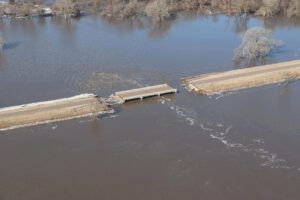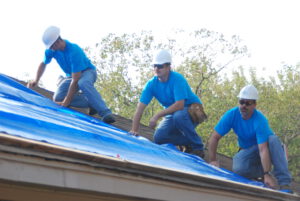T
he U.S. Army Corps of Engineers has significant flood control responsibilities, both during times of preparation and during emergency events. During floods, it cooperates with state, county, and local governments, diking districts and levee boards, the Federal Emergency Management Agency (FEMA), and other entities.
Steve Stockton, a senior advisor to the National Water Resources Association (NWRA) and Water Strategies, worked for the Army Corps for 41 years. In this conversation with Municipal Water Leader Managing Editor Joshua Dill, Mr. Stockton details how the Army Corps works to respond to floods and what local entities should know about working with it.

Joshua Dill: For readers who don’t know you, would you please introduce yourself ?
Steve Stockton: I worked for 41 years for the U.S. Army Corps of Engineers, the last 11 as director of civil works at the Army Corps’s headquarters. Civil works is one of the Army Corps’s two major programs, alongside military programs. The civil works side is responsible for navigation, flood control, aquatic ecosystem restoration, hydropower, and municipal and industrial water supply. It’s a broad range of responsibilities. There are about 25,000 people in the civil works program, and we have about 700 dams, about 240 lock chambers, thousands of miles of levees, and thousands of miles of inland navigable waterways—more than the rest of the world combined. We have an emergency response program to support FEMA under emergency support function 3, which is for public works and engineering. We’re responsible for dredging all the ports in the United States. I retired about 21/2 years ago and am currently a senior advisor for the NWRA and Water Strategies.
Joshua Dill: How does flood control and response fit into the broader range of Army Corps responsibilities?
Steve Stockton: It’s one of its primary responsibilities. Most of the Army Corps’s more than 700 dams primarily serve flood-control and navigation functions. However, multipurpose dams, like the ones on the Missouri River, have about eight functions. One function is providing flood- control storage, which requires keeping empty space in the reservoir. The other seven functions—hydropower, navigation, water supply, irrigation, fish and wildlife enhancement, and recreation—require retaining water upstream. Reconciling those two needs is a balancing act that depends on the hydrology of the region. The whole Missouri system has been litigated many times. In the early 2000s, the Army Corps, in coordination with other federal, state, and local entities, developed a master manual for the Missouri River, which includes a prescription for balancing water storage and flood- control storage.
Joshua Dill: When a large-scale disaster like the recent flooding in Nebraska occurs, what are the Army Corps’s duties?
Steve Stockton: In emergency response mode, the Army Corps assists local communities with flood fighting, emergency repairs to levees, and managing the reservoir system to reduce flood flows. However, there’s always a bigger flood. I like to say that Mother Nature bats last. You have to manage the system based on averages, but something new can always happen. I’ve done a little reading on what happened during this flood event. There are six dams on the Missouri River. The lower two are basically reregulating dams and don’t have any substantial flood-control storage; most of the flood-control storage is in the upper four dams. In the recent flooding, when the storm came in, the ground was frozen, there was snow pack, and then there was rain. There was nowhere for the water to go except back into the river. The system has a lot of flood-control storage, but Mother Nature did not cooperate, and most of the rainfall occurred downstream of those facilities.

Joshua Dill: In the disaster response activities you mentioned, what other entities does the Army Corps work with and what is the breakdown of responsibilities?
Steve Stockton: The Army Corps is in charge of the public works and engineering emergency support function under the National Disaster Response plan. We work under the direction of FEMA, which gives us mission assignments and directives. We also have our own authorities under Public Law (PL) 84-99, which allows us to assist local stakeholders with emergency repairs and emergency flood protection management measures, like distributing sandbags. In the case of flood control, the Army Corps’s responsibilities are to respond to the event and to help local communities recover under the direction of FEMA.
Joshua Dill: In cases in which you are assisting local stakeholders, how does that occur in practice? Does a state or local government call the Army Corps?
Steve Stockton: The Army Corps coordinates with state governments, county governments, and nonfederal sponsors. Typically, though, if levee districts and diking districts have their levees in the PL 84-99 program, and they properly maintain their levees and get certified and accredited every year, then they’re eligible to receive the benefits of the program. Most of the Army Corps’s work is directly with the levee districts. Aside from the PL 84-99 program, we can still get mission assignments from FEMA. Those missions often include the emergency roofing of structures, known as Operation Blue Roof, and logistic support for generators and debris removal.
Joshua Dill: What should local government entities know about how best to cooperate with the Army Corps?
Steve Stockton: Diking districts and levee boards should be participating with the Army Corps during annual inspections and building personal relationships during normal, nondisaster times. There are 38 Army Corps civil works districts in the United States, and it is primarily a civilian organization. Diking districts and levee boards should know who the points of contact are, who the authorities are, and what their shared responsibilities are.
Joshua Dill: What are the best ways to establish those relationships?

Steve Stockton: Invite Army Corps staff out to see the projects and visit them at least a couple times a year in their offices to go over issues of mutual concern. As in any kind of relationship building, the two parties need to know each other and understand each other’s roles and responsibilities as well as their limitations and constraints. For instance, John Winkler, the general manager of the Papio-Missouri River Natural Resources District, has a good relationship with the Omaha District. He talked to the district engineer, who is a colonel, several times a day during the flood event. He knows the people to talk to and what the issues are. It is also good to be part of a professional organization like the NWRA, which allows members to share strategy, lessons learned, and advice about how to work with different Army Corps districts and how they resolve policy issues. Don’t try to do everything yourself. There’s strength in numbers, especially when you are trying to change policies or pass legislation.
Joshua Dill: Is there anything else you wanted to talk about?
Steve Stockton: The Army Corps is always a lightning rod when a disaster occurs because people want to blame somebody. The Army Corps will be as responsive as possible within its authority and within the appropriated money that it has. You can reduce risk, but you can’t eliminate it. There’s always a bigger storm.
Steve Stockton is a senior advisor to the National Water Resources Association and Water Strategies and is the retired director of civil works for the U.S. Army Corps of Engineers.
He can be contacted at sstockton@nwra.org.
